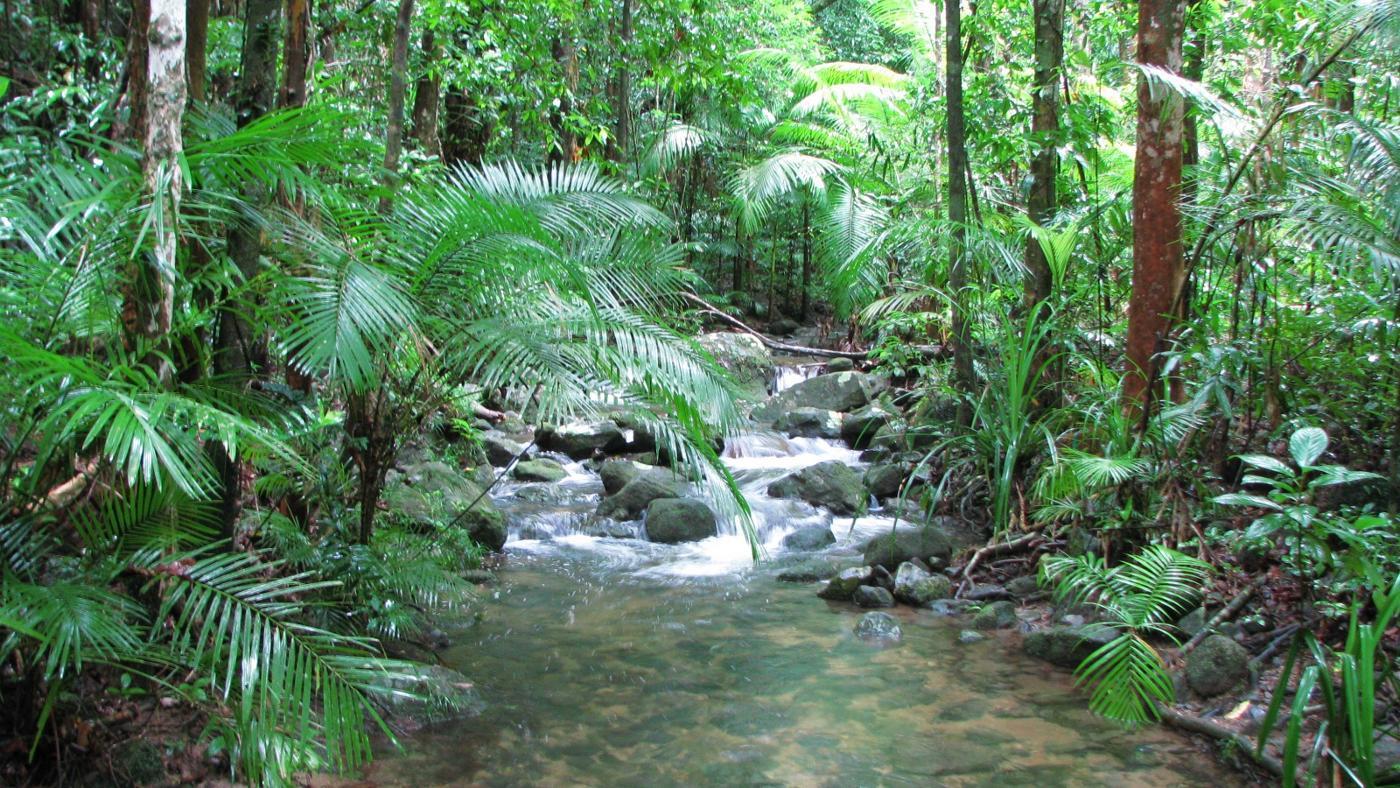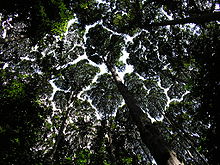WHAT ARE RAIN FORESTS?
What are rain forests
 Many of the world's tropical forests are associated with the location of the monsoon trough, also known as the intertropical convergence zone.[7] The broader category of tropical moist forests are located in the equatorial zone between the Tropic of Cancer and Tropic of Capricorn. Tropical rainforests exist in Southeast Asia (from Myanmar (Burma) to the Philippines, Malaysia, Indonesia, Papua New Guinea, Sri Lanka, Sub-Saharan Africa from Cameroon to the Congo (Congo Rainforest), South America (e.g. the Amazon Rainforest), Central America (e.g. Bosawás, southern Yucatán Peninsula-El Peten-Belize-Calakmul), Australia, and on many of the Pacific Islands (such as Hawaiʻi). Tropical forests have been called the "Earth's lungs", although it is now known that rainforests contribute little net oxygen addition to the atmosphere through photosynthesis.
Many of the world's tropical forests are associated with the location of the monsoon trough, also known as the intertropical convergence zone.[7] The broader category of tropical moist forests are located in the equatorial zone between the Tropic of Cancer and Tropic of Capricorn. Tropical rainforests exist in Southeast Asia (from Myanmar (Burma) to the Philippines, Malaysia, Indonesia, Papua New Guinea, Sri Lanka, Sub-Saharan Africa from Cameroon to the Congo (Congo Rainforest), South America (e.g. the Amazon Rainforest), Central America (e.g. Bosawás, southern Yucatán Peninsula-El Peten-Belize-Calakmul), Australia, and on many of the Pacific Islands (such as Hawaiʻi). Tropical forests have been called the "Earth's lungs", although it is now known that rainforests contribute little net oxygen addition to the atmosphere through photosynthesis.
Rainforests are forests characterized by high rainfall, with annual rainfall in the case of tropical rainforests between 250 and 450 centimetres (98 and 177 in),[1] and definitions varying by region for temperate rainforests. The monsoon trough, alternatively known as the intertropical convergence zone, plays a significant role in creating the climatic conditions necessary for the Earth's tropical rainforests.
Around 40% to 75% of all biotic species are indigenous to the rainforests.[2] It has been estimated that there may be many millions of species of plants, insects and microorganisms still undiscovered in tropical rainforests. Tropical rainforests have been called the "jewels of the Earth" and the "world's largest pharmacy", because over one quarter of natural medicines have been discovered there.[3] Rainforests are also responsible for 28% of the world's oxygen turnover, sometimes misnamed oxygen production,[4] processing it through photosynthesis from carbon dioxide and consuming it through respiration.
The undergrowth in some areas of a rainforest can be restricted by poor penetration of sunlight to ground level. If the leaf canopy is destroyed or thinned, the ground beneath is soon colonized by a dense, tangled growth of vines, shrubs and small trees, called a jungle. The term jungle is also sometimes applied to tropical rainforests generally.
TROPICAL RAIN FORESTS
Tropical rainforests are characterized by a warm and wet climate with no substantial dry season: typically found within 10 degrees north and south of the equator. Mean monthly temperatures exceed 18 °C (64 °F) during all months of the year.[5] Average annual rainfall is no less than 168 cm (66 in) and can exceed 1,000 cm (390 in) although it typically lies between 175 cm (69 in) and 200 cm (79 in).[6]
 Many of the world's tropical forests are associated with the location of the monsoon trough, also known as the intertropical convergence zone.[7] The broader category of tropical moist forests are located in the equatorial zone between the Tropic of Cancer and Tropic of Capricorn. Tropical rainforests exist in Southeast Asia (from Myanmar (Burma) to the Philippines, Malaysia, Indonesia, Papua New Guinea, Sri Lanka, Sub-Saharan Africa from Cameroon to the Congo (Congo Rainforest), South America (e.g. the Amazon Rainforest), Central America (e.g. Bosawás, southern Yucatán Peninsula-El Peten-Belize-Calakmul), Australia, and on many of the Pacific Islands (such as Hawaiʻi). Tropical forests have been called the "Earth's lungs", although it is now known that rainforests contribute little net oxygen addition to the atmosphere through photosynthesis.
Many of the world's tropical forests are associated with the location of the monsoon trough, also known as the intertropical convergence zone.[7] The broader category of tropical moist forests are located in the equatorial zone between the Tropic of Cancer and Tropic of Capricorn. Tropical rainforests exist in Southeast Asia (from Myanmar (Burma) to the Philippines, Malaysia, Indonesia, Papua New Guinea, Sri Lanka, Sub-Saharan Africa from Cameroon to the Congo (Congo Rainforest), South America (e.g. the Amazon Rainforest), Central America (e.g. Bosawás, southern Yucatán Peninsula-El Peten-Belize-Calakmul), Australia, and on many of the Pacific Islands (such as Hawaiʻi). Tropical forests have been called the "Earth's lungs", although it is now known that rainforests contribute little net oxygen addition to the atmosphere through photosynthesis.
LAYERS O RAINFORESTS
A tropical rainforest typically has a number of layers, each with different plants and animals adapted for life in that particular area. Examples include the emergent, canopy, understorey and forest floor layers.
Emergent layer
The emergent layer contains a small number of very large trees called emergents, which grow above the general canopy, reaching heights of 45–55 m, although on occasion a few species will grow to 70–80 m tall.[11][12] They need to be able to withstand the hot temperatures and strong winds that occur above the canopy in some areas. Eagles, butterflies, bats and certain monkeys inhabit this layer.
Canopy layer
Main article: Canopy (biology)
The canopy layer contains the majority of the largest trees, typically 30 metres (98 ft) to 45 metres (148 ft) tall. The densest areas of biodiversity are found in the forest canopy, a more or less continuous cover of foliage formed by adjacent treetops. The canopy, by some estimates, is home to 50 percent of all plant species. Epiphytic plants attach to trunks and branches, and obtain water and minerals from rain and debris that collects on the supporting plants. The fauna is similar to that found in the emergent layer, but more diverse. A quarter of all insect species are believed to exist in the rainforest canopy. Scientists have long suspected the richness of the canopy as a habitat, but have only recently developed practical methods of exploring it. As long ago as 1917, naturalist William Beebe declared that "another continent of life remains to be discovered, not upon the Earth, but one to two hundred feet above it, extending over thousands of square miles." True exploration of this habitat only began in the 1980s, when scientists developed methods to reach the canopy, such as firing ropes into the trees using crossbows. Exploration of the canopy is still in its infancy, but other methods include the use of balloons and airships to float above the highest branches and the building of cranes and walkways planted on the forest floor. The science of accessing tropical forest canopy using airships or similar aerial platforms is called dendronautics.[13]
Understory layer
Main article: Understory
The understory or understorey layer lies between the canopy and the forest floor. It is home to a number of birds, snakes and lizards, as well as predators such as jaguars, boa constrictors and leopards. The leaves are much larger at this level and insect life is abundant. Many seedlings that will grow to the canopy level are present in the understory. Only about 5% of the sunlight shining on the rainforest canopy reaches the understory. This layer can be called a shrub layer, although the shrub layer may also be considered a separate layer.
Forest floor
Main article: Forest floor
The forest floor, the bottom-most layer, receives only 2% of the sunlight. Only plants adapted to low light can grow in this region. Away from riverbanks, swamps and clearings, where dense undergrowth is found, the forest floor is relatively clear of vegetation because of the low sunlight penetration. It also contains decaying plant and animal matter, which disappears quickly, because the warm, humid conditions promote rapid decay. Many forms of fungi growing here help decay the animal and plant waste.
SO NOW YOU KNOW LITTLE ON RAIN FORESTS.


This comment has been removed by a blog administrator.
ReplyDelete